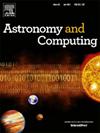Accelerating universe in f(R,Lm) gravity
IF 1.8
4区 物理与天体物理
Q2 ASTRONOMY & ASTROPHYSICS
引用次数: 0
Abstract
This paper investigates the dynamics of cosmic expansion within the framework of gravity, focusing on the late-time behavior of the universe modeled as a flat Friedmann–Lemaître–Robertson–Walker spacetime. We derive an analytical solution for the field equations and employ advanced statistical techniques, including the Markov Chain Monte Carlo (MCMC) method, to determine best-fit values for the key cosmological parameters, such as the Hubble parameter and the deceleration parameter. Our findings reveal a transition from a decelerating to an accelerating phase of cosmic expansion, aligning closely with observational data as in the CDM model. The analysis of energy conditions indicates that the strong energy condition is violated, in keeping with the current accelerated expansion of the universe and the nature of dark energy. By elucidating the quintessence behavior of our model through statefinder and Om diagnostics, this study contributes to a deeper understanding of cosmic evolution and the fundamental forces at play. The insights gained pave the way for future research into alternative cosmological models, inviting further exploration of the mysteries surrounding dark energy and the ultimate fate of the universe.
f(R,Lm) 引力下的加速宇宙
本文在 f(R,Lm) 引力框架内研究了宇宙膨胀的动力学,重点是以平坦的弗里德曼-勒梅特尔-罗伯逊-沃克时空为模型的宇宙晚期行为。我们推导出了场方程的解析解,并采用了先进的统计技术,包括马尔可夫链蒙特卡洛(MCMC)方法,以确定哈勃参数和减速参数等关键宇宙学参数的最佳拟合值。我们的发现揭示了宇宙膨胀从减速阶段向加速阶段的过渡,与 ΛCDM 模型中的观测数据非常吻合。对能量条件的分析表明,强能量条件被违反了,这与当前宇宙的加速膨胀和暗能量的性质是一致的。这项研究通过状态探测器和 Om 诊断阐明了我们模型的本质行为,有助于加深对宇宙演化和基本作用力的理解。所获得的洞察力为未来研究其他宇宙学模型铺平了道路,并将进一步探索围绕暗能量和宇宙最终命运的奥秘。
本文章由计算机程序翻译,如有差异,请以英文原文为准。
求助全文
约1分钟内获得全文
求助全文
来源期刊

Astronomy and Computing
ASTRONOMY & ASTROPHYSICSCOMPUTER SCIENCE,-COMPUTER SCIENCE, INTERDISCIPLINARY APPLICATIONS
CiteScore
4.10
自引率
8.00%
发文量
67
期刊介绍:
Astronomy and Computing is a peer-reviewed journal that focuses on the broad area between astronomy, computer science and information technology. The journal aims to publish the work of scientists and (software) engineers in all aspects of astronomical computing, including the collection, analysis, reduction, visualisation, preservation and dissemination of data, and the development of astronomical software and simulations. The journal covers applications for academic computer science techniques to astronomy, as well as novel applications of information technologies within astronomy.
 求助内容:
求助内容: 应助结果提醒方式:
应助结果提醒方式:


